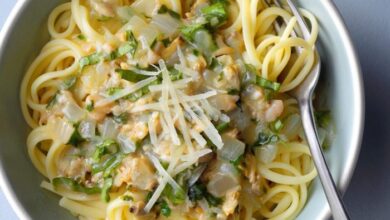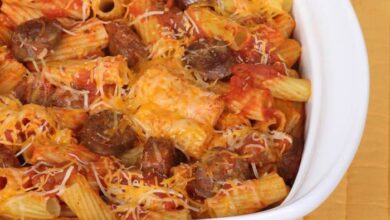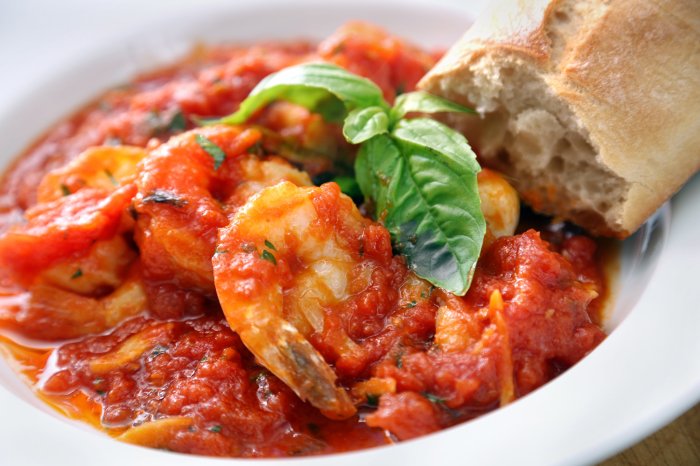
Shrimp Spaghetti with Tomato Sauce: A Classic Italian Delight
Shrimp spaghetti with tomato sauce takes center stage, a classic Italian dish that’s both comforting and incredibly flavorful. This beloved pasta creation is a testament to the simplicity and brilliance of Italian cuisine, offering a perfect balance of fresh ingredients and bold flavors.
The origins of this dish can be traced back to the coastal regions of Italy, where fresh seafood and ripe tomatoes were readily available. Over time, shrimp spaghetti with tomato sauce evolved into a staple in Italian households and restaurants, becoming a cherished culinary tradition passed down through generations.
Shrimp Spaghetti with Tomato Sauce: A Culinary Journey
The aroma of garlic and tomato sauce, the al dente bite of spaghetti, and the sweet, succulent shrimp – these are the elements that make shrimp spaghetti with tomato sauce a culinary masterpiece. I still remember the first time I tasted this dish; it was at a small Italian restaurant tucked away in a bustling city.
The flavors were so rich and vibrant, the textures so perfectly balanced, that it left an indelible mark on my palate. This dish, with its simplicity and depth, is a testament to the beauty of Italian cuisine.
Origins and History of Shrimp Spaghetti with Tomato Sauce
Shrimp spaghetti with tomato sauce, like many beloved dishes, has a rich and fascinating history. While its exact origins are debated, it is generally believed to have emerged in the coastal regions of Italy, where seafood and tomatoes were readily available.
The use of tomatoes in Italian cooking dates back to the 16th century, when they were introduced from the Americas. The combination of tomatoes, garlic, olive oil, and herbs formed the foundation of many classic Italian sauces, including the one used in shrimp spaghetti.
Shrimp spaghetti with tomato sauce is a classic for a reason – it’s simple, flavorful, and always satisfying. But sometimes, I crave something a little more hearty and comforting. That’s when I turn to crispy bean and cheese burritos , with their warm, cheesy filling and crispy exterior.
After all, a little variety keeps things interesting, and both dishes are perfect for a weeknight meal.
The dish’s popularity grew throughout the 19th and 20th centuries, becoming a staple in Italian households and restaurants worldwide. Its versatility, affordability, and deliciousness have made it a beloved dish across cultures and generations.
Ingredients and Preparation
A simple yet flavorful dish, shrimp spaghetti with tomato sauce relies on a handful of key ingredients and a few essential cooking techniques. The freshness of your ingredients will significantly impact the final outcome, so choosing high-quality ingredients is crucial.
Let’s dive into the specifics.
Ingredients
The following ingredients are essential for creating a delicious shrimp spaghetti with tomato sauce:
- Shrimp:Choose fresh, raw shrimp, peeled and deveined, for the best flavor. The quantity will depend on your desired serving size. A general guideline is about 1/2 pound of shrimp per person.
- Spaghetti:Opt for high-quality spaghetti, preferably durum wheat pasta. This type of pasta holds its shape well during cooking and absorbs the sauce beautifully. The amount of spaghetti will vary based on your appetite.
- Tomato Sauce:You can use store-bought tomato sauce or make your own. If making your own, use ripe tomatoes, onions, garlic, and herbs like basil and oregano.
- Olive Oil:Extra virgin olive oil is preferred for its rich flavor and aroma. Use a good quality olive oil for a more flavorful dish.
- Garlic:Fresh garlic adds a pungent and savory flavor to the dish. Use 2-3 cloves of garlic, minced or crushed.
- Onion:A small onion, finely chopped, adds sweetness and depth to the sauce.
- Salt and Pepper:Season the dish to taste with salt and freshly ground black pepper.
- Red Pepper Flakes:A pinch of red pepper flakes adds a touch of heat. Adjust the amount based on your preference.
- Fresh Parsley:Chopped fresh parsley adds a vibrant, fresh flavor and a touch of color to the dish.
Preparation
Preparing shrimp spaghetti with tomato sauce is a straightforward process, but using proper techniques ensures a delicious result:
- Prepare the shrimp:Rinse the shrimp and pat them dry. If using frozen shrimp, thaw them completely before cooking.
- Cook the spaghetti:Bring a large pot of salted water to a boil. Add the spaghetti and cook according to the package directions until al dente.
- Make the tomato sauce:In a large skillet, heat the olive oil over medium heat. Add the onion and cook until softened, about 5 minutes. Add the garlic and cook for another minute. Pour in the tomato sauce and bring to a simmer.
Season with salt, pepper, and red pepper flakes to taste.
- Cook the shrimp:Add the shrimp to the simmering tomato sauce. Cook for 2-3 minutes, or until the shrimp are pink and cooked through.
- Combine the spaghetti and sauce:Drain the cooked spaghetti and add it to the skillet with the shrimp and sauce. Toss to combine.
- Serve:Serve the shrimp spaghetti with tomato sauce immediately, garnished with fresh parsley.
Variations and Adaptations
Shrimp spaghetti with tomato sauce, while a classic, offers endless possibilities for personalization and adaptation. From choosing different pasta shapes to incorporating various seafood additions, the dish can be customized to suit individual tastes and dietary needs.
Pasta Shapes
The choice of pasta shape can significantly influence the overall texture and presentation of the dish. While spaghetti is the most common choice, other shapes like linguine, fettuccine, or even penne can be used. Linguine, with its flat, ribbon-like shape, provides a good surface area for the sauce to cling to, while fettuccine, slightly wider and thicker, offers a more substantial bite.
Penne, with its tubular shape, can hold more sauce, creating a more flavorful experience.
Seafood Additions
Beyond shrimp, other seafood can be added to create a more complex and flavorful dish. Mussels, clams, scallops, or even lobster can be incorporated into the recipe. Mussels and clams add a briny flavor, while scallops provide a delicate sweetness.
Lobster, with its rich and luxurious flavor, can elevate the dish to a special occasion meal.
Flavor Profiles
The flavor profile of the tomato sauce can be customized by adding various herbs, spices, and other ingredients. Fresh basil, oregano, and parsley are classic additions, while chili flakes, garlic, and onion can add depth and complexity. For a more Mediterranean twist, consider adding capers, olives, or sun-dried tomatoes.
A dash of red pepper flakes can provide a subtle kick, while a pinch of sugar can balance the acidity of the tomatoes.
Dietary Restrictions and Preferences, Shrimp spaghetti with tomato sauce
The recipe can be adapted to suit various dietary restrictions and preferences. For a gluten-free option, use gluten-free pasta. For a vegetarian version, omit the shrimp and add additional vegetables like mushrooms, zucchini, or eggplant. For a vegan version, use plant-based alternatives for the cheese and broth.
Regional Variations
Shrimp spaghetti with tomato sauce is a dish enjoyed worldwide, and different regions have their own unique variations. In Italy, the dish is often made with a simple tomato sauce, while in Spain, it may include chorizo or other Spanish sausages.
In the United States, the dish is often served with a creamy Alfredo sauce or a spicy marinara sauce.
Serving Suggestions
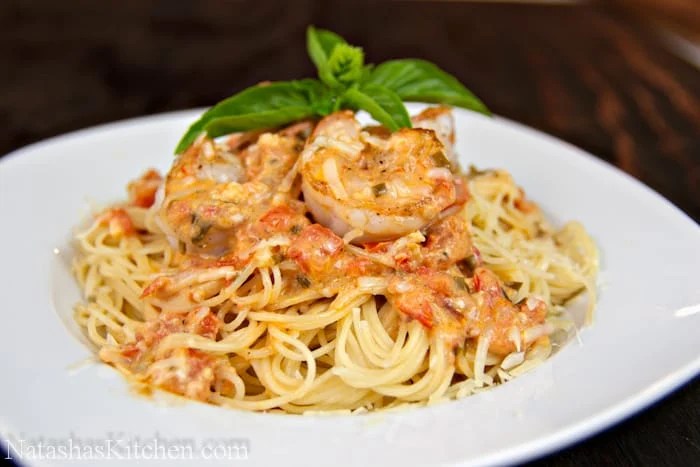
Shrimp spaghetti with tomato sauce is a dish that can be enjoyed hot and fresh. The ideal serving temperature is between 160°F and 170°F (71°C and 77°C). This temperature allows the flavors of the dish to shine and ensures that the pasta is cooked through without being overcooked.
Plating Techniques
Plating techniques play a crucial role in presenting a dish. A simple yet elegant way to plate shrimp spaghetti with tomato sauce is to use a shallow pasta bowl. The pasta should be arranged in a mound in the center of the bowl, with a generous amount of sauce covering the pasta.
The shrimp can be placed on top of the pasta, or arranged around the perimeter of the bowl. A sprinkle of fresh parsley or basil adds a touch of color and freshness.
Complementary Side Dishes
A light and refreshing salad is a perfect complement to the richness of shrimp spaghetti with tomato sauce. A simple salad of mixed greens, cherry tomatoes, and a light vinaigrette is a classic pairing. A side of garlic bread or crusty bread can also be served to soak up any remaining sauce.
Beverages
A chilled white wine, such as a Pinot Grigio or Sauvignon Blanc, is a perfect pairing for shrimp spaghetti with tomato sauce. The acidity of the wine cuts through the richness of the dish, while the fruity notes complement the flavors of the shrimp and tomato sauce.
A light beer, such as a Pilsner or Lager, is also a good choice.
Shrimp spaghetti with tomato sauce is a classic for a reason – it’s quick, flavorful, and always a crowd-pleaser. But sometimes, you want something a little more substantial. For those nights, I love whipping up a easy leg of lamb – it’s impressive yet surprisingly simple.
Then, to round out the meal, I always serve it with a side of shrimp spaghetti, the perfect balance of light and hearty.
Garnishes and Presentation
Garnishes and presentation can elevate the visual appeal of a dish. Fresh parsley, basil, or oregano are common garnishes for shrimp spaghetti with tomato sauce. A sprinkle of grated Parmesan cheese adds a touch of richness and saltiness.
Shrimp spaghetti with tomato sauce is a classic for a reason! The sweet and savory flavors of the shrimp and sauce are a perfect match. I like to add a bit of spice to my sauce with some red pepper flakes.
But sometimes, I crave a little sweetness, and that’s when I turn to the recipe for old fashioned pumpkin butter I found online. The pumpkin butter adds a touch of fall magic to the dish, making it even more satisfying.
The dish can be presented in a rustic bowl or on a white plate for a more elegant look.
Nutritional Information
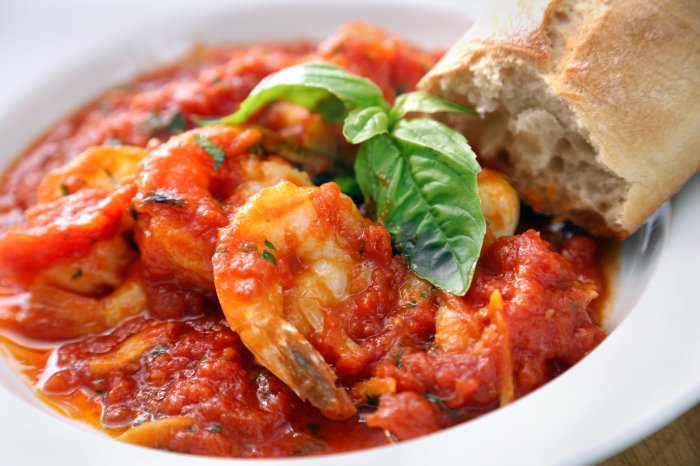
Shrimp spaghetti with tomato sauce is a flavorful and satisfying dish, but it’s important to consider its nutritional value and potential health implications. This section will delve into the nutritional breakdown of the dish, highlighting its benefits and drawbacks, and providing tips for making it a healthier choice.
Nutritional Value
Shrimp spaghetti with tomato sauce is a source of protein, carbohydrates, and some essential nutrients. The nutritional content can vary depending on the ingredients used and the portion size. A typical serving of shrimp spaghetti with tomato sauce might contain:
- Calories:Approximately 400-500 calories, depending on the pasta type and sauce ingredients.
- Protein:Around 20-30 grams, primarily from the shrimp.
- Carbohydrates:Roughly 60-80 grams, mainly from the pasta.
- Fat:Approximately 10-15 grams, with a balance of saturated and unsaturated fats.
- Fiber:Limited fiber content, unless whole-wheat pasta is used.
- Vitamins and Minerals:Shrimp is a good source of selenium, vitamin B12, and iodine. Tomatoes provide lycopene, vitamin C, and potassium.
Health Benefits
Shrimp spaghetti with tomato sauce can offer several health benefits, including:
- Protein Source:Shrimp is a lean protein source, providing essential amino acids for muscle growth and repair.
- Antioxidant Rich:Tomatoes are rich in lycopene, a powerful antioxidant that may help protect against certain types of cancer and heart disease.
- Heart-Healthy Fats:Shrimp contains omega-3 fatty acids, which are beneficial for heart health.
Potential Drawbacks
While shrimp spaghetti with tomato sauce can be a nutritious meal, it’s important to be mindful of some potential drawbacks:
- Sodium Content:Canned tomatoes and some sauces can be high in sodium, which can contribute to high blood pressure.
- Added Sugar:Some tomato sauces contain added sugar, which can increase calorie intake and contribute to weight gain.
- Limited Fiber:Traditional pasta is low in fiber, which can contribute to digestive issues.
Healthier Alternatives
To make shrimp spaghetti with tomato sauce a healthier choice, consider these tips:
- Use Whole-Wheat Pasta:Whole-wheat pasta is a good source of fiber and nutrients compared to refined pasta.
- Choose Low-Sodium Broth:If using broth in the sauce, opt for low-sodium or no-salt-added varieties.
- Make Your Own Sauce:Making your own sauce allows you to control the ingredients and reduce added sugar and sodium.
- Add Vegetables:Incorporate a variety of vegetables, such as bell peppers, onions, and mushrooms, to increase the fiber and nutrient content.
Cultural Significance
While shrimp spaghetti with tomato sauce may not have a specific cultural origin story like some traditional dishes, it has become a beloved staple in various culinary landscapes around the world. Its popularity stems from the versatility of the ingredients and the ease of preparation, making it a dish that transcends borders and cultural differences.
The Global Reach of Shrimp Spaghetti
Shrimp spaghetti with tomato sauce is a testament to the interconnectedness of culinary traditions. The dish is enjoyed in numerous countries, with each region adding its own unique twist. For example, in Italy, the dish is often served with a simple tomato sauce, while in the United States, it is commonly found with a creamy Alfredo sauce.
- In Mediterranean cultures, shrimp spaghetti is often served with fresh herbs like basil and oregano, reflecting the region’s emphasis on simple, flavorful ingredients.
- In Asian cuisine, shrimp spaghetti may be prepared with a spicy chili sauce or a sweet and sour sauce, reflecting the region’s bold and diverse flavors.
- In Latin America, shrimp spaghetti is often served with a vibrant salsa, adding a layer of complexity and spice to the dish.
Cultural Impact on Cuisine and Society
Shrimp spaghetti with tomato sauce has become a popular choice for home cooks and chefs alike, highlighting the accessibility and adaptability of the dish. Its global appeal speaks to the universal desire for a flavorful and satisfying meal.
- The dish has become a popular choice for family gatherings, social events, and casual dining experiences.
- Its ease of preparation makes it a perfect dish for busy weeknights, while its versatility allows for endless variations to suit different palates.
- The dish has also become a staple in restaurants worldwide, often appearing on menus as a classic Italian-inspired option.
Culinary Techniques: Shrimp Spaghetti With Tomato Sauce
Shrimp spaghetti with tomato sauce is a dish that relies on a few key culinary techniques to achieve its signature flavors and textures. The success of this dish lies in the careful execution of these techniques, ensuring that each component is cooked to perfection and harmonizes with the others.
Cooking the Shrimp
Shrimp, being a delicate protein, requires careful cooking to avoid overcooking and rubberiness. The ideal method is to pan-fry them in a hot pan with a bit of oil or butter. The high heat sears the shrimp quickly, creating a flavorful crust while keeping the interior tender and juicy.
The cooking time is brief, usually a few minutes per side, depending on the size of the shrimp.
- Timing: The key to cooking shrimp perfectly is timing. Overcooking can result in tough and rubbery shrimp, while undercooking can leave them raw and unsafe to eat. The optimal cooking time depends on the size of the shrimp.
As a general rule, smaller shrimp cook faster than larger ones.
- Temperature Control: High heat is crucial for searing the shrimp and creating a flavorful crust. A hot pan allows for quick cooking, ensuring that the shrimp are cooked through without drying out.
- Ingredient Selection: Fresh shrimp are essential for this dish. Look for shrimp that are firm, have a slightly sweet smell, and have a translucent appearance. Avoid shrimp that have a strong fishy odor or are discolored.
Preparing the Tomato Sauce
The tomato sauce is the heart of this dish, providing a rich and flavorful base for the shrimp and pasta. The key to a good tomato sauce is to simmer it slowly, allowing the flavors to meld and deepen.
- Timing: Simmering the sauce for a longer period of time allows the flavors to develop and the sauce to thicken. A good rule of thumb is to simmer the sauce for at least 30 minutes.
- Temperature Control: Low and slow is the key to a flavorful tomato sauce. Simmering the sauce over low heat prevents it from burning and allows the flavors to develop gradually.
- Ingredient Selection: The quality of the tomatoes is crucial for a delicious sauce. Use ripe, flavorful tomatoes, whether fresh or canned. Adding aromatics like garlic, onions, and herbs enhances the complexity of the sauce.
Cooking the Spaghetti
Spaghetti, the star of the show, needs to be cooked al dente, meaning firm to the bite. This texture is achieved by boiling the pasta in salted water until it is cooked through but still has a slight resistance.
- Timing: The cooking time for spaghetti varies depending on the thickness of the pasta. Check the package instructions for the recommended cooking time. Overcooked pasta will be mushy, while undercooked pasta will be hard and crunchy.
- Temperature Control: Boiling water is essential for cooking spaghetti. The water should be vigorously boiling, creating a swirling motion that helps the pasta cook evenly.
- Ingredient Selection: Choose high-quality spaghetti made from durum wheat semolina. This type of pasta holds its shape well and has a pleasant texture.
Assembling the Dish
Once the shrimp, tomato sauce, and spaghetti are cooked, it’s time to assemble the dish. The key here is to combine the components in a way that enhances the overall flavor and texture.
- Timing: The shrimp should be added to the sauce just before serving to prevent them from overcooking. The spaghetti should be drained and tossed with the sauce immediately to prevent it from becoming sticky.
- Temperature Control: The sauce should be hot when it is tossed with the spaghetti and shrimp. This ensures that the dish is served hot and flavorful.
- Ingredient Selection: A sprinkle of freshly grated Parmesan cheese adds a final touch of flavor and richness to the dish.
Tips and Tricks
Mastering the art of shrimp spaghetti with tomato sauce is a journey of flavor and technique. This section delves into practical tips and tricks to elevate your dish from good to exceptional, offering insights on troubleshooting common issues and creating a truly memorable dining experience.
Maximizing Shrimp Flavor
- Properly Deveining:Remove the dark vein running along the shrimp’s back to enhance flavor and prevent a gritty texture. A sharp knife or a skewer can be used for this purpose.
- Seasoning:Seasoning shrimp generously with salt and pepper before cooking enhances their natural flavor. A pinch of paprika or garlic powder adds depth.
- Cooking Time:Overcooking shrimp can lead to rubbery texture. Cook shrimp until just opaque, about 2-3 minutes per side, for optimal tenderness.
- Pan-Searing:Searing shrimp in a hot pan with a little oil creates a beautiful golden crust and enhances flavor.
Tomato Sauce Mastery
- Freshness:Use fresh, ripe tomatoes for the best flavor. Canned tomatoes can be used as a convenient alternative, but choose high-quality brands with minimal additives.
- Balance:Adjust the sweetness and acidity of the tomato sauce by adding sugar or lemon juice, as needed.
- Herbs and Spices:Enhance the tomato sauce with aromatic herbs like basil, oregano, and thyme, or add a touch of heat with red pepper flakes.
- Simmering:Simmer the tomato sauce for at least 30 minutes to allow the flavors to meld and deepen.
Spaghetti Perfection
- Al Dente:Cook the spaghetti al dente, meaning it should have a slight bite to it. This ensures the pasta doesn’t become mushy when combined with the sauce.
- Starchy Water:Reserve some of the starchy pasta water before draining. This can be added to the sauce to help thicken it and create a more cohesive sauce.
- Sauce to Pasta Ratio:Aim for a sauce-to-pasta ratio that allows the pasta to be coated evenly but not drowning in sauce.
Troubleshooting Common Issues
- Overcooked Shrimp:If shrimp are overcooked, they become tough and rubbery. Cook them for a shorter time next time, or use a lower heat.
- Bland Sauce:A bland sauce can be remedied by adding more salt, pepper, herbs, or a pinch of sugar.
- Too Thick Sauce:If the sauce is too thick, add a little pasta water or broth to thin it out.
Elevate the Dining Experience
- Garnish:A sprinkle of freshly grated Parmesan cheese, chopped parsley, or a drizzle of olive oil adds a touch of elegance to the dish.
- Side Dishes:Pair the shrimp spaghetti with a simple side salad or crusty bread for a complete meal.
- Presentation:Serve the dish in a visually appealing manner, using a large plate and arranging the pasta and shrimp artfully.
Visual Representation
A picture is worth a thousand words, and when it comes to food, a visually appealing presentation can elevate the dining experience. Let’s explore the diverse world of shrimp spaghetti with tomato sauce through visual representations.
Variations of Shrimp Spaghetti with Tomato Sauce
A simple dish can be transformed into an endless array of flavors and textures. Here’s a table showcasing different variations of shrimp spaghetti with tomato sauce, highlighting their unique characteristics:
| Variation | Key Ingredients | Flavor Profile |
|---|---|---|
| Classic Shrimp Spaghetti with Tomato Sauce | Shrimp, garlic, onion, canned tomatoes, olive oil, basil, oregano, salt, pepper, spaghetti | Savory, tangy, slightly sweet, with a hint of garlic and herbs |
| Shrimp Spaghetti with Spicy Tomato Sauce | Shrimp, garlic, onion, canned tomatoes, olive oil, chili flakes, basil, oregano, salt, pepper, spaghetti | Savory, tangy, slightly sweet, with a kick of spice from chili flakes |
| Shrimp Spaghetti with White Wine Tomato Sauce | Shrimp, garlic, onion, canned tomatoes, white wine, olive oil, basil, oregano, salt, pepper, spaghetti | Savory, tangy, slightly sweet, with a subtle hint of wine and a richer flavor |
| Shrimp Spaghetti with Creamy Tomato Sauce | Shrimp, garlic, onion, canned tomatoes, heavy cream, olive oil, basil, oregano, salt, pepper, spaghetti | Savory, tangy, slightly sweet, with a creamy and luxurious texture |
| Shrimp Spaghetti with Pesto Tomato Sauce | Shrimp, garlic, onion, canned tomatoes, pesto, olive oil, salt, pepper, spaghetti | Savory, tangy, slightly sweet, with a vibrant and aromatic flavor from the pesto |
Visual Guide to Preparing Shrimp Spaghetti with Tomato Sauce
A visual guide can simplify the cooking process, breaking it down into manageable steps. Here’s a step-by-step illustration of preparing shrimp spaghetti with tomato sauce:
1. Gather your ingredients
This includes shrimp, garlic, onion, canned tomatoes, olive oil, basil, oregano, salt, pepper, and spaghetti.
2. Prepare the shrimp
Peel and devein the shrimp, then season with salt and pepper.
3. Sauté the garlic and onion
Heat olive oil in a large skillet over medium heat, then add minced garlic and chopped onion. Sauté until softened.
4. Add the tomatoes
Pour in the canned tomatoes, crushing them with a spoon. Season with salt, pepper, basil, and oregano.
5. Simmer the sauce
Bring the sauce to a simmer and cook for 15-20 minutes, stirring occasionally.
6. Cook the spaghetti
While the sauce is simmering, cook the spaghetti according to package directions.
7. Add the shrimp
Once the sauce has thickened, add the shrimp to the skillet and cook until pink and opaque.
8. Combine the spaghetti and sauce
Drain the cooked spaghetti and add it to the skillet with the shrimp and sauce. Toss to combine.
9. Serve and enjoy
Garnish with fresh basil and serve immediately.


